Wayne C. Allen's Blog, page 7
June 23, 2024
The Myth of Shoulds — The Myths Series
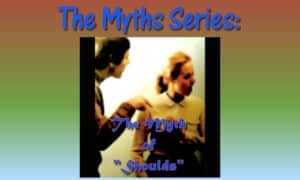
The Myth of “Shoulds” — “shoulds” are declarations of opinion projected on others

Want to learn more about living a full and meaningful life?
Want to have the best relationship ever?
Check out my books
“Shoulds” are the personalization of something that we declare to be an absolute. In other words, a “should” is a statement that some truth is self-evident, and “should” therefore be followed by others.We’ve talked about the myth of absolutes, so stating that something is “self-evidently and absolutely true” is already on shaky ground.
This is because what is true for me is not “self-evidently true” for you.
The person who “declares a should” moves from, “This is “true” for me” to this is “true for everyone.” From there, they self-righteously declare: “I should,” so “You should.”
They emphasize how “obvious” the “should” is.Even though, as we all know, nothing is obvious — and there’s not a hell of a lot that is self-evident, or even evident.
It doesn’t matter how craftily you word a “should” — it’s all the same nonsense.
Now, some people are clever enough to drop the word “should.” They’ll try something like: “If you love me, you’d agree with me.” Others lamely point to authorities, declaring, “I just read a book and took a course, and I absolutely know for sure what you need to do.” It’s no better when you say, “You should understand me.” All of which begs the question, “Why should (must I) I be interested in understanding you? Maybe you’re boring or just full of yourself.”
I love watching kids grow up. And part of growing up is discovering that being an adult means moving farther away from their parents’ perceptions and ways of doing things.
This process involves exploring, challenging, and shifting core beliefs.
However, most teens do the normal, teen thing. They replace their parents’ structures and ways of doing things with those of their peer group.
One teen and I were talking about sex and dating, and as we dug in, she said “I can’t talk to my parents about this stuff.” I asked her what she did do. “I ask my friends,” was her reply.
Now, I heard that and I wondered: “What could another 15-year-old possibly know about that or any other adult topic?” But I held my tongue and offered to listen and to answer any questions she chose to ask.
All teens do this little dance of trading one fervently held view for another equally rigid belief. I want them to grow up–to get over thinking there is a “right” answer, or that there is something they “should” be doing.Odds are, though, most won’t. Not without help.
Unfortunately, most folk simply shift from one set of rigid beliefs to another as they try to find the “correct list” — the perfect list of “shoulds” — without ever questioning the premise, “Why do I think I (or others) should do anything?”
We don’t question ourselves because we believe in “shoulds.”As kids, we hear stuff like, “You should be ashamed of yourself.” Parents do this to us to get us to fit in to their preconceived notions of how we “should” behave.
The only thing we really learn is that big people think that there is a universal list of “shoulds” that coincidentally matches what those big people already believe.
Much of relationship distress is a direct result of having a “should list” about how a “husband” or “wife” or partner (or ex!) ought to be behaving. Each person grasps onto their list as if it is real, as opposed to a construction of their imagination and perhaps a creation of our culture.
Then, in their ignorance and audacity, they compare their partner to their made-up list, find the partner lacking, and try to force or manipulate them to change.
All of this happens because we give more power to an imagined list than to the person standing right there in front of us.What getting over ourselves and our need to control others gains us is a better understanding of what’s actually happening.
If I can’t relate with someone, it’s not because they are violating my list of “shoulds.” I don’t like the way they are behaving … wait for it … because I don’t like the way they are behaving.
That’s not to say that people don’t screw up. It’s about whether I think I have the right to attempt to impose my “shoulds” on another.So, say I’m in a highly functional relationship, and I bump my nose against what my partner is doing. As I consider the issue, but before raising it, I take the time to listen to what I am hurting myself over — to what I am “objecting to.”
I ask myself, “Do I think there is some way my partner “should” be behaving that I can let go of?”
If I truly believe that raising the issue would benefit the relationship, I would say, “Here is what I am noticing that you are doing, and here is what I am making of it.”
This is not a request for my partner to change. This is a statement of my observations, which others can take or leave.In this highly functional relationship, you and I would have an understanding that when one of us comments in this decidedly neutral way, the recipient will respond by looking at what they are doing–that “you” will not simply dismiss what I am saying as being “my issue.”
In other words, my comments wouldinvite you to look at yourself.
And this would happen in both directions, obviously.The point of commenting is to create an environment of exploration for both parties. It is not to get the other person to follow one mode of being (one list of “shoulds.”)
Choosing this way is self-responsible and self-directed.Comparing a person to an abstraction and then trying to get the person to change to fit the abstraction simply does not work. When I see, over time, that what I want and what I am getting does not match, I have three choices,
I can accept the difference without complaint, and simply be curious, orI can whine, manipulate and try to control the person into “changing,” “seeing the light,” “waking up,” “getting it,” “reading the right book” — and make life miserable for them until they do, orI can leave. And by this I mean actually leave — many people leave, and continue to try to manipulate their ex into “behaving” — all for the “right” reasons, of course!The middle option is, by far, the most common.
My favourite, direct from the mouths of clients: “I’ll treat you with respect when you stop drinking.” “I’ll stop drinking when you treat me with respect.” Both are indignantly superior in their “rightness,” their, “everyone knows how you should be behaving-ness.”
And, of course, nothing changes.This week, notice your “shoulds,” your “Gee, your life would be better if only you would change to make me happy” list. Notice your, “I just don’t get why you don’t change. It’s self-evident” comments. Find your own place. Stop. Breathe. Look at your options. Then, work toward choice 1 or choice 3.
Facebook TwitterThe Myth of Shoulds — The Myths Series

The Myth of “Shoulds” — “shoulds” are declarations of opinion projected on others

Want to learn more about living a full and meaningful life?
Want to have the best relationship ever?
Check out my books
“Shoulds” are the personalization of something that we declare to be an absolute. In other words, a “should” is a statement that some truth is self-evident, and “should” therefore be followed by others.We’ve talked about the myth of absolutes, so stating that something is “self-evidently and absolutely true” is already on shaky ground.
This is because what is true for me is not “self-evidently true” for you.
The person who “declares a should” moves from, “This is “true” for me” to this is “true for everyone.” From there, they self-righteously declare: “I should,” so “You should.”
They emphasize how “obvious” the “should” is.Even though, as we all know, nothing is obvious — and there’s not a hell of a lot that is self-evident, or even evident.
It doesn’t matter how craftily you word a “should” — it’s all the same nonsense.
Now, some people are clever enough to drop the word “should.” They’ll try something like: “If you love me, you’d agree with me.” Others lamely point to authorities, declaring, “I just read a book and took a course, and I absolutely know for sure what you need to do.” It’s no better when you say, “You should understand me.” All of which begs the question, “Why should (must I) I be interested in understanding you? Maybe you’re boring or just full of yourself.”
I love watching kids grow up. And part of growing up is discovering that being an adult means moving farther away from their parents’ perceptions and ways of doing things.
This process involves exploring, challenging, and shifting core beliefs.
However, most teens do the normal, teen thing. They replace their parents’ structures and ways of doing things with those of their peer group.
One teen and I were talking about sex and dating, and as we dug in, she said “I can’t talk to my parents about this stuff.” I asked her what she did do. “I ask my friends,” was her reply.
Now, I heard that and I wondered: “What could another 15-year-old possibly know about that or any other adult topic?” But I held my tongue and offered to listen and to answer any questions she chose to ask.
All teens do this little dance of trading one fervently held view for another equally rigid belief. I want them to grow up–to get over thinking there is a “right” answer, or that there is something they “should” be doing.Odds are, though, most won’t. Not without help.
Unfortunately, most folk simply shift from one set of rigid beliefs to another as they try to find the “correct list” — the perfect list of “shoulds” — without ever questioning the premise, “Why do I think I (or others) should do anything?”
We don’t question ourselves because we believe in “shoulds.”As kids, we hear stuff like, “You should be ashamed of yourself.” Parents do this to us to get us to fit in to their preconceived notions of how we “should” behave.
The only thing we really learn is that big people think that there is a universal list of “shoulds” that coincidentally matches what those big people already believe.
Much of relationship distress is a direct result of having a “should list” about how a “husband” or “wife” or partner (or ex!) ought to be behaving. Each person grasps onto their list as if it is real, as opposed to a construction of their imagination and perhaps a creation of our culture.
Then, in their ignorance and audacity, they compare their partner to their made-up list, find the partner lacking, and try to force or manipulate them to change.
All of this happens because we give more power to an imagined list than to the person standing right there in front of us.What getting over ourselves and our need to control others gains us is a better understanding of what’s actually happening.
If I can’t relate with someone, it’s not because they are violating my list of “shoulds.” I don’t like the way they are behaving … wait for it … because I don’t like the way they are behaving.
That’s not to say that people don’t screw up. It’s about whether I think I have the right to attempt to impose my “shoulds” on another.So, say I’m in a highly functional relationship, and I bump my nose against what my partner is doing. As I consider the issue, but before raising it, I take the time to listen to what I am hurting myself over — to what I am “objecting to.”
I ask myself, “Do I think there is some way my partner “should” be behaving that I can let go of?”
If I truly believe that raising the issue would benefit the relationship, I would say, “Here is what I am noticing that you are doing, and here is what I am making of it.”
This is not a request for my partner to change. This is a statement of my observations, which others can take or leave.In this highly functional relationship, you and I would have an understanding that when one of us comments in this decidedly neutral way, the recipient will respond by looking at what they are doing–that “you” will not simply dismiss what I am saying as being “my issue.”
In other words, my comments wouldinvite you to look at yourself.
And this would happen in both directions, obviously.The point of commenting is to create an environment of exploration for both parties. It is not to get the other person to follow one mode of being (one list of “shoulds.”)
Choosing this way is self-responsible and self-directed.Comparing a person to an abstraction and then trying to get the person to change to fit the abstraction simply does not work. When I see, over time, that what I want and what I am getting does not match, I have three choices,
I can accept the difference without complaint, and simply be curious, orI can whine, manipulate and try to control the person into “changing,” “seeing the light,” “waking up,” “getting it,” “reading the right book” — and make life miserable for them until they do, orI can leave. And by this I mean actually leave — many people leave, and continue to try to manipulate their ex into “behaving” — all for the “right” reasons, of course!The middle option is, by far, the most common.
My favourite, direct from the mouths of clients: “I’ll treat you with respect when you stop drinking.” “I’ll stop drinking when you treat me with respect.” Both are indignantly superior in their “rightness,” their, “everyone knows how you should be behaving-ness.”
And, of course, nothing changes.This week, notice your “shoulds,” your “Gee, your life would be better if only you would change to make me happy” list. Notice your, “I just don’t get why you don’t change. It’s self-evident” comments. Find your own place. Stop. Breathe. Look at your options. Then, work toward choice 1 or choice 3.
Facebook TwitterJune 16, 2024
The Myth of the Threat of Change — The Myths Series
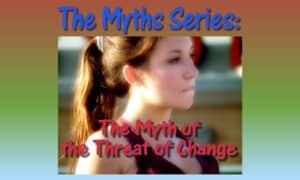
The Myth of the Threat of Change — many people fear change, so they stay stuck. Yet the fear is almost always baseless.

Want to learn more about living a full and meaningful life?
Want to have the best relationship ever?
Check out my books
 Laughing in the face of change
Laughing in the face of changeJohn Savage, a trainer in conflict resolution, described various “neuro-sorting” techniques to help us see how our minds are set up.
Research backs up the percentages below. (i.e. it’s not fake news…  )
)
One is called the “Sameness — Difference Sort. It speaks to the threat of change.”
10% of the population are Sameness types. They actively resist change. Profound change for these folk happens once every 25 years.40% are Sameness/Difference types. They prefer to stay the same, but will change if strongly convinced. The make a profound change once in 10 years.40% are Difference/Sameness types. They prefer change, but like it to be gradual and non-threatening. They make profound changes once every 5 years, and prefer newness. (Savage equates them with people who shop at the same mall, because there are 100 stores, as opposed to trying a new mall.)10% are Difference types. They thrive on change and stagnate if things get too predictable. They embrace change as a friend. They change profoundly almost yearly. Savage calls them “channel surfers.”It doesn’t take Einstein to see that 90% of the population resists making changes. Profound, earth-shaking change? Leave me out.So… what about the model we use and teach?To shift to the Zen-based self-responsibility model is to change the entire belief system you are operating under.
Under this model, rules, behaviours, standards, ethics — all become conditional, situational and self-determined. Scary stuff.
Given the above, 90% of the population will, at some level, resist making this (or any significant) shift.
The level of resistance tells us where on the bell curve the person is.
10% of the population will “never” change.80% will change if persuaded, coerced or convinced that it is in their best interest to do so.As we move more to the right on the bell curve, the more likely it is that the person will see the need for change.At the 85% and above stage, the person may even seek help in changing.For the top 5%, change is relatively effortless.This demonstrates why we say that change terrifies the vast majority of people.People can be herded anywhere, so long as each step is small.
Make a huge change, and they’ll be out in the streets, protesting. Incremental change, and anything can happen.
Look at the population of Germany in the 30’s. Hitler did what he did through incremental change.
He presented a message about a return to the old ways of thinking, then tossed out someone to blame, and in a few years, almost the whole population shifted.
Shades of Trump today. Same topics, same change model, same goal.
The funny thing is, though, change is actually the “truth” of life.Everything is changing, all the time.
This scares us; it does so because at a deep, primal level, we recognize that the direction of the change, for us as individuals, is death.
Each day brings death one day closer, so we try to hold on, as opposed to flowing along comfortably in the sea of change.
Because we fear change, we are stuck in denial.Change is only as threatening as we make it. We needlessly complicate our lives by fearing what is already our reality. The world is changing at a faster pace than ever before in history, and the pace of change is accelerating. You can try to fight it, but all you are going to do is hurt yourself in the process.
Much better to talk with someone about processing through to a new, self-responsible state. It’s not easy, but it is do-able.
Because staying stuck in a dysfunctional belief system is a sure way to waste 5 years… or 50. It’s a great way to be content being miserable.
After all, it’s not like life goes on forever. Misery and stuckness is a choice. A better one is to set yourself free.
Facebook TwitterThe Myth of the Threat of Change — The Myths Series

The Myth of the Threat of Change — many people fear change, so they stay stuck. Yet the fear is almost always baseless.

Want to learn more about living a full and meaningful life?
Want to have the best relationship ever?
Check out my books
 Laughing in the face of change
Laughing in the face of changeJohn Savage, a trainer in conflict resolution, described various “neuro-sorting” techniques to help us see how our minds are set up.
Research backs up the percentages below. (i.e. it’s not fake news…  )
)
One is called the “Sameness — Difference Sort. It speaks to the threat of change.”
10% of the population are Sameness types. They actively resist change. Profound change for these folk happens once every 25 years.40% are Sameness/Difference types. They prefer to stay the same, but will change if strongly convinced. The make a profound change once in 10 years.40% are Difference/Sameness types. They prefer change, but like it to be gradual and non-threatening. They make profound changes once every 5 years, and prefer newness. (Savage equates them with people who shop at the same mall, because there are 100 stores, as opposed to trying a new mall.)10% are Difference types. They thrive on change and stagnate if things get too predictable. They embrace change as a friend. They change profoundly almost yearly. Savage calls them “channel surfers.”It doesn’t take Einstein to see that 90% of the population resists making changes. Profound, earth-shaking change? Leave me out.So… what about the model we use and teach?To shift to the Zen-based self-responsibility model is to change the entire belief system you are operating under.
Under this model, rules, behaviours, standards, ethics — all become conditional, situational and self-determined. Scary stuff.
Given the above, 90% of the population will, at some level, resist making this (or any significant) shift.
The level of resistance tells us where on the bell curve the person is.
10% of the population will “never” change.80% will change if persuaded, coerced or convinced that it is in their best interest to do so.As we move more to the right on the bell curve, the more likely it is that the person will see the need for change.At the 85% and above stage, the person may even seek help in changing.For the top 5%, change is relatively effortless.This demonstrates why we say that change terrifies the vast majority of people.People can be herded anywhere, so long as each step is small.
Make a huge change, and they’ll be out in the streets, protesting. Incremental change, and anything can happen.
Look at the population of Germany in the 30’s. Hitler did what he did through incremental change.
He presented a message about a return to the old ways of thinking, then tossed out someone to blame, and in a few years, almost the whole population shifted.
Shades of Trump today. Same topics, same change model, same goal.
The funny thing is, though, change is actually the “truth” of life.Everything is changing, all the time.
This scares us; it does so because at a deep, primal level, we recognize that the direction of the change, for us as individuals, is death.
Each day brings death one day closer, so we try to hold on, as opposed to flowing along comfortably in the sea of change.
Because we fear change, we are stuck in denial.Change is only as threatening as we make it. We needlessly complicate our lives by fearing what is already our reality. The world is changing at a faster pace than ever before in history, and the pace of change is accelerating. You can try to fight it, but all you are going to do is hurt yourself in the process.
Much better to talk with someone about processing through to a new, self-responsible state. It’s not easy, but it is do-able.
Because staying stuck in a dysfunctional belief system is a sure way to waste 5 years… or 50. It’s a great way to be content being miserable.
After all, it’s not like life goes on forever. Misery and stuckness is a choice. A better one is to set yourself free.
Facebook TwitterJune 9, 2024
The Myth of Right and Wrong — The Myths Series
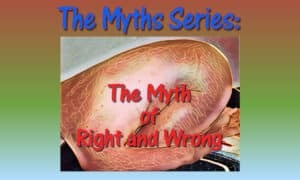
The Myth of Right and Wrong–there are always exceptions to each “rule,” and making a list isn’t particularly helpful
For more on this topic, check out:

My first and most popular book,
This Endless Moment.
Learn to live a full and satisfying life.
The reason for this is how we learn “right” from “wrong.”
Being a child means having an almost instant feedback loop, otherwise known as parents.
When we were kids, doing “wrong” got us punished, and doing “right” got us some form of reward. As adults, we still sorta expect this kind of feedback, even if we dread it. In fact, many people get married hoping to be parented, or to parent, their spouses. And it’s quite funny how the focus of such folk is always external — on their partner — as opposed to self-reflective.But back, briefly, to parenting.
The funny thing is, the vast majority of things declared by our parents and tribes to be “right” or “wrong” are simply their personal preferences.
For example, one woman I worked with decades ago grew up in a one-parent household. Her dad left when she was a kid. Her mom never got over his leaving her. On a regular basis, mom would say, “Men can’t be trusted. Every man will hurt and abandon you.”
Guess what my client believed? This mom-mantra became, for her, a “rule.” A “truth.” And indeed, every man she picked cheated on her, and then left her. She fervently believed that “this was the way it is,” and because of this, she created situations and circumstances that her men would do what she feared (expected.)
Thing is, there’s no “right” or “wrong” about it.Additionally, there’s the whole issue (discussed at length in Ben Wong & Jock McKeen’s The NEW Manual for Life) of the repression of the authentic self that is a part of all human conditioning.
Babies come into the world as a bundle of potentiality. Each child is born with an authentic self — a unique set of ways of being and doing, and of all of that “stuff” will come under pressure.
This authentic self, this complete self, will be sliced and diced by what I call in my book This Endless Moment the T&C (our tribes and culture.) Parts of us (our skills, characteristics, and characters) will be approved of, and other parts will be rejected.
The parts that are rejected go background, and agitate and mess with us from what Jung called The Shadow.An acquaintance of ours remembers having a deeply artistic bent when she was a kid. Her parents were in the sciences, and, using all kinds of manipulations, kept reinforcing the idea that “In our family, we don’t make art, we donate to the arts” and “Painting is not a career.”
When she was around the age 8 they took all of her art supplies away, and refused to buy her more. She stopped all forms of painting and art. They upped the ante and made art “wrong,” and had the power to enforce their belief.
Her artist finally went background.
Mom and dad continued to stress the sciences as the only “right” career. In her teens, she rebelled, but in a typically teen way. She didn’t go back and examine her parents’ assumptions — she had bought into their belief system, and declared, “I’m not an artist” and “Being an artist is bad.” What she did do was become sexually active at 14, and she dropped out of High School at 16, ending the whole “become a scientist” thing.
She became a secretary. She figured, “That’ll show them!”
Of course, she really only hurt herself, and totally missed what had been going on.
Ten years went by. During that time she painted three paintings. She hid them in the closet in her apartment. I saw one, one day — it was a depiction of three people in a very hot clinch. We started talking about art.
Over time, her story came out. With much effort, she let go of the art / science, “bad” / “good” nonsense, finished High School, and enrolled in a University Arts program.
But there’s more to the story.T&C (often in the guise of parental lectures / diatribes) doesn’t stop pressuring for compliance when we become teens. All that changes is the “maturity” of the topics.
When my friend was a young teen, mom and dad started criticizing her appearance, clothes choices, and her developing body. When puberty hit, her mother continually stressed that sex was “bad,” — something to be put up with and gotten past.
Both messages “went in,” and changed her beliefs about herself:
In my opinion she was quite attractive and well-proportioned. She needed to paint a self-portrait for Art Class, and I shot a portrait series for her. Lovely photos. Then I saw her sketches: she drew herself as old, ugly and fat. Because she had learned to believe that her that her body was “wrong.”Although sexually active since 14, she didn’t enjoy sex. She called it, “Going through the motions.” Just as mom taught her.Each of her beliefs — her “good and bad list” — come from her formative years — and it is so for all of us.As we get older, we do change some of the items on our “good” / “bad” list, but the hard part is when I suggest that people do away with lists entirely.
The problem with lists is that they let people off the hook. With a list,to default to, people no longer need to engage in moment-by-moment, issue by issue thinking.
And that’s too bad, because all people, given encouragement (notice that word en-courage-ment) have the ability to make ethical and behavioural choices situationally, and on the fly.
Since we met, Darbella and I have been experimenting with a radical idea. It’s simple. If something comes up and either of us want to attach a knee-jerk “right / wrong” label to it, we explore it.
If something scares us, we tend to do it. (see caveats, below.) And, if something interests us, we give it a shot.
This means that we are better able to spot any “right / wrong rules” we might have. We then examine the rule and see if it actually makes sense.
Besides, if we decide to do something despite our fear of it, will the sky fall in?Better, we think, to actually find out through our own experience than to stop ourselves based upon someone else’s opinion.
Because in the main, the things we have the strongest reaction to tend to be the most embedded, and therefore taught to us by T&C. T&C had an agenda back then, and we forget that at our peril. They wanted to create clones that fit in.
Which is not to say, and here’s the caveat, that I’m going to try Russian roulette. I also have opted out of bungee jumping. Not because someone else told me to, but because my fear-level is sufficient to not need to test these things.
On the other hand, discovering and exploring the pieces of my authentic self — the parts of me that my parents taught me to put away, actually liking and using and training my body — well, that’s a different story.
Take a look at the things about yourself that you declare to be “bad.” Are they really “bad,” or did they just fly in the face of what your tribe wanted of you? Explore what you judge to be “wrong” about others. Same criteria. Is it “wrong,” or just different? (This is especially true of cultural judgements, aka racism. Almost all of it is “just different.”)
And lastly, look at those actions and acts you think might be fun — but you just know are “wrong!!!!” Why? What would it be like, with a clear heart and total honesty, to give one or two a chance? Then decide if you want to repeat the experience.
Because, speaking for me, I don’t want to be lying on my death-bed with a ton of regrets.
If it’s scary, chargy, or new, just do it.
Facebook TwitterThe Myth of Right and Wrong — The Myths Series

The Myth of Right and Wrong–there are always exceptions to each “rule,” and making a list isn’t particularly helpful
For more on this topic, check out:

My first and most popular book,
This Endless Moment.
Learn to live a full and satisfying life.
The reason for this is how we learn “right” from “wrong.”
Being a child means having an almost instant feedback loop, otherwise known as parents.
When we were kids, doing “wrong” got us punished, and doing “right” got us some form of reward. As adults, we still sorta expect this kind of feedback, even if we dread it. In fact, many people get married hoping to be parented, or to parent, their spouses. And it’s quite funny how the focus of such folk is always external — on their partner — as opposed to self-reflective.But back, briefly, to parenting.
The funny thing is, the vast majority of things declared by our parents and tribes to be “right” or “wrong” are simply their personal preferences.
For example, one woman I worked with decades ago grew up in a one-parent household. Her dad left when she was a kid. Her mom never got over his leaving her. On a regular basis, mom would say, “Men can’t be trusted. Every man will hurt and abandon you.”
Guess what my client believed? This mom-mantra became, for her, a “rule.” A “truth.” And indeed, every man she picked cheated on her, and then left her. She fervently believed that “this was the way it is,” and because of this, she created situations and circumstances that her men would do what she feared (expected.)
Thing is, there’s no “right” or “wrong” about it.Additionally, there’s the whole issue (discussed at length in Ben Wong & Jock McKeen’s The NEW Manual for Life) of the repression of the authentic self that is a part of all human conditioning.
Babies come into the world as a bundle of potentiality. Each child is born with an authentic self — a unique set of ways of being and doing, and of all of that “stuff” will come under pressure.
This authentic self, this complete self, will be sliced and diced by what I call in my book This Endless Moment the T&C (our tribes and culture.) Parts of us (our skills, characteristics, and characters) will be approved of, and other parts will be rejected.
The parts that are rejected go background, and agitate and mess with us from what Jung called The Shadow.An acquaintance of ours remembers having a deeply artistic bent when she was a kid. Her parents were in the sciences, and, using all kinds of manipulations, kept reinforcing the idea that “In our family, we don’t make art, we donate to the arts” and “Painting is not a career.”
When she was around the age 8 they took all of her art supplies away, and refused to buy her more. She stopped all forms of painting and art. They upped the ante and made art “wrong,” and had the power to enforce their belief.
Her artist finally went background.
Mom and dad continued to stress the sciences as the only “right” career. In her teens, she rebelled, but in a typically teen way. She didn’t go back and examine her parents’ assumptions — she had bought into their belief system, and declared, “I’m not an artist” and “Being an artist is bad.” What she did do was become sexually active at 14, and she dropped out of High School at 16, ending the whole “become a scientist” thing.
She became a secretary. She figured, “That’ll show them!”
Of course, she really only hurt herself, and totally missed what had been going on.
Ten years went by. During that time she painted three paintings. She hid them in the closet in her apartment. I saw one, one day — it was a depiction of three people in a very hot clinch. We started talking about art.
Over time, her story came out. With much effort, she let go of the art / science, “bad” / “good” nonsense, finished High School, and enrolled in a University Arts program.
But there’s more to the story.T&C (often in the guise of parental lectures / diatribes) doesn’t stop pressuring for compliance when we become teens. All that changes is the “maturity” of the topics.
When my friend was a young teen, mom and dad started criticizing her appearance, clothes choices, and her developing body. When puberty hit, her mother continually stressed that sex was “bad,” — something to be put up with and gotten past.
Both messages “went in,” and changed her beliefs about herself:
In my opinion she was quite attractive and well-proportioned. She needed to paint a self-portrait for Art Class, and I shot a portrait series for her. Lovely photos. Then I saw her sketches: she drew herself as old, ugly and fat. Because she had learned to believe that her that her body was “wrong.”Although sexually active since 14, she didn’t enjoy sex. She called it, “Going through the motions.” Just as mom taught her.Each of her beliefs — her “good and bad list” — come from her formative years — and it is so for all of us.As we get older, we do change some of the items on our “good” / “bad” list, but the hard part is when I suggest that people do away with lists entirely.
The problem with lists is that they let people off the hook. With a list,to default to, people no longer need to engage in moment-by-moment, issue by issue thinking.
And that’s too bad, because all people, given encouragement (notice that word en-courage-ment) have the ability to make ethical and behavioural choices situationally, and on the fly.
Since we met, Darbella and I have been experimenting with a radical idea. It’s simple. If something comes up and either of us want to attach a knee-jerk “right / wrong” label to it, we explore it.
If something scares us, we tend to do it. (see caveats, below.) And, if something interests us, we give it a shot.
This means that we are better able to spot any “right / wrong rules” we might have. We then examine the rule and see if it actually makes sense.
Besides, if we decide to do something despite our fear of it, will the sky fall in?Better, we think, to actually find out through our own experience than to stop ourselves based upon someone else’s opinion.
Because in the main, the things we have the strongest reaction to tend to be the most embedded, and therefore taught to us by T&C. T&C had an agenda back then, and we forget that at our peril. They wanted to create clones that fit in.
Which is not to say, and here’s the caveat, that I’m going to try Russian roulette. I also have opted out of bungee jumping. Not because someone else told me to, but because my fear-level is sufficient to not need to test these things.
On the other hand, discovering and exploring the pieces of my authentic self — the parts of me that my parents taught me to put away, actually liking and using and training my body — well, that’s a different story.
Take a look at the things about yourself that you declare to be “bad.” Are they really “bad,” or did they just fly in the face of what your tribe wanted of you? Explore what you judge to be “wrong” about others. Same criteria. Is it “wrong,” or just different? (This is especially true of cultural judgements, aka racism. Almost all of it is “just different.”)
And lastly, look at those actions and acts you think might be fun — but you just know are “wrong!!!!” Why? What would it be like, with a clear heart and total honesty, to give one or two a chance? Then decide if you want to repeat the experience.
Because, speaking for me, I don’t want to be lying on my death-bed with a ton of regrets.
If it’s scary, chargy, or new, just do it.
Facebook TwitterJune 2, 2024
The Myth of Absolute Truth — The Myths Series
The Myth of Absolute Truth — we hate not knowing, but the reality is, most of life is a mystery to be lived, not a puzzle to be solved.
Of Wayne’s many books, the one closest to today’s topic is: This Endless Moment

My first and most popular book,
This Endless Moment.
Learn to live a full and satisfying life.
From that point on, he spent his time frustrating himself trying to discover what is called the “Unified Field Theory.” To quote Compton’s On-Line Encyclopaedia,
Loose Ends — when the pieces won’t fitIn their work some physicists have tried to construct a unified field theory that would describe all fundamental forces in nature and the relationships between elementary particles in terms of a single theory. So far, all such attempts have failed, though experiments and tests of several hypotheses are still under investigation.
Gravity has not yet been accounted for in a unified field theory … In physics, forces can be described by fields that mediate interactions between separate objects, such as between planets or between electrons…in the early 20th century, Albert Einstein developed general relativity, his field theory of gravitation.
Einstein and others later unsuccessfully attempted to construct a unified field theory in which electromagnetism and gravity would emerge as different aspects of a single fundamental field.
Human beings hate loose ends — those unsolvable moments that surround us. our hatred of the unknown or the unsolvable is almost pathological.
As infants, we were told how to view things. This conditioning is necessary, as we need explanations for… well… everything.
We don’t realize that we are not being given “the truth.” We are being given one version of many. IN my books, I’ve called this the imprinting of Tribe & Culture. (T&C)
Because our parents are big and keep us alive… because tribes are powerful — the message comes across that there is only one way to see things — and “coincidentally” it’s the way our parents, tribe and educational system see things.
For many people, this restrictive view of the universe, faith, life-perspective — never changes.Some will argue that there is change during adolescence.
Adolescents are notorious for thinking that their opinions are totally unique. This is, of course, foolishness.
Adolescence is nothing more than a time for trading one “herd” for another.

When I look at photos of myself from University in the late 60s, I certainly looked different from my parents. But I perfectly blended in with my peers. Long hair, beard, weird clothes… all markers of my new “tribe.”
For most, the main thing is “belonging”… and to belong is to accept the “Absolute Truth” of the beliefs espoused by group to which one belongs.
The most blatant example of this today Is MAGA. Nothing, it seems, will blow MAGA beliefs out of the heads of its herd, despite evidence to the contrary.
We play the absolute truth game so that we don’t scare ourselves with how unpredictable life is.We don’t want to think about how “different” each of our world-views are — going there, doing that, and your head might explode. We desperately want “people” to “get it.” The “it” we want them to “get,” is how we see the world.
Many people continually frustrate themselves over how stupid other people are.Being in Costa Rica is a great demonstration.
Many are the expats down here who bemoan the “Tico way.” I do this every time I repair something plugged into the electrical grid.
Back home in Canada, I “wire to code” — a euphemism for following the rules. Here, wires poke out of drywall, are taped together, no boxes, etc.
I want to fix it all, and then I calm down and just put things back the way they were, only working.
But others loudly proclaim how slow and backward things and people are. I just laugh and remind them that “You ain’t in Kansas any more.”
This also plays out in “field dependency. (FD)”FD is defined as continually monitoring “the field,” and then adapting one’s self and one’s view to that “field” — to the people around us.
It’s what we’re describing above, under adolescence, but broader. It’s captured in the line, “What would people think?”
The FD person will move mountains to fit in, even if what they are choosing to do flies in the face of who they are. So, we end up going off in two directions at once.
We attempt to become the people we choose to relate to while at the same time we attempt to create universal rules that others “should” abide by, never noticing that those rules “just happen” to be what we already believe to be so.
The stronger the latter belief, the more arrogant the person becomes. And the more closed.
The solution to this “myth” is to “get over yourself.”The getting over involves letting go of thinking that there is a “Unified Field Theory of Behaviour.” If there is one, it is this: “Everything is changing and nothing is true.” Here’s a long quote from Brad Blanton, author of Radical Honesty, on this topic: (pg. 239f)
How Things Are
None of us are ever really looking at how it is out there. I have my view of “how things are.” You have your view of “how things are.” We have to depend, in case of disagreement, on another nut like ourselves (a friend, therapist, or judge) with some other view of “how things are” to arbitrate for us.
And it’s no accident that “arbitrate” comes form the same root word arbitrary. The truth is, none of us ever know what is going on. We just agree to have beliefs in common as a way of keeping things together.
It’s amazing how we copy each other’s views so well that we can have such organized living. It’s pretty amazing how groups of us are willing to defend to the death our interpretations against other groups’ interpretations, or punish “crooked” interpretations within our own groups.
It’s amazing because there is really no way to tell if “out there” is out there or not. But whatever it is, it’s all created by individual beings, who then get together and agree what to call it.
Assuming that seeing, hearing, smelling and so on are chemical reactions in organisms, then each individual organism, as I argued in Chapter One, is the creator of the world.
We have to see if our creations agree with each other by doing a lot of cross-checking in the course of growing up.
Even then, just at the perceptual level, it’s hard to get agreement among people about what the world really is and what it is like. Science is a formal attempt to agree on the criteria we are willing to accept as a basis of agreement, in advance of any agreements.
In that way the laws and agreed-upon assumptions of science are just like the laws and agreed-upon assumptions of the U.S. Constitution. We humans have spent a lot of time and energy for the past several thousand years trying to get clear on our agreements about perception and our agreements about value. People kill each other by the minute over what it all means.
The solution probably won’t ever be just having everyone believe the same thing. Instead of working toward commonality of views, we need to work toward common acceptance of the principle of variety.
We need a variety of ways to look at how things are, because ultimately we have a better chance of supporting each other with a lot of ways of viewing things.
It may feel less secure than if everyone agrees on what is true, but feeling of security is just that — a feeling, not the real thing.
Less secure is often more reliable. If there is not enough variety preserved in the gardens of illusion about “how things are,” then some version of 1984 totalitarianism will come true. This scenario is almost as bad as the more tragic one of being blown away or dying of poison.
I think communal acceptance of variety of illusions, with less murderous defense of belief, is a better solution.
Blanton’s book was published in 1994. Those last few lines, about totalitarianism, so perfectly fit with the rise of The Donald. He’s doing what we’re talking about: providing simple, facile arguments about reality (Mexicans, Arabs, women, etc.) that some people are desperate to swallow — in order to feel a part of “the in group” they feel excluded from.
Please note that I am not declaring Blanton’s view “true,” (nor am I declaring the prior paragraph “true…”)Blanton’s approach fits well with what I write about. He invites us to question everything, to recognize that our “answers” are provisional, and that anything and everything is in a state of flux.
And that this includes everything that we believe to be “absolute.”
With each of the myths in this series, I’m trying to get you to stretch your mind enough so that you’ll simply let go — that you’ll notice how your beliefs, and your beliefs alone, have the power to keep you stuck.
I have faith that “answers,” such as they are, often reside in the body — at the level of perception of experience.
That I experience something is significant. Why I experience something as I do is a head game with no helpful outcome.Such head “answers” change all the time and absolutely do not tell you anything about anyone else. My thoughts about others are all about me.
Notice your absolutes. You’ll find them by listening for “everyone” or “no one.” Beyond “everyone is born and dies,” (and other biological absolutes) there is nothing “everyone or no one” does.
Social consensus is simply that. We used to be into slavery, remember?
When it comes to behaviour, anything and everything is possible. The only authentic question is, “is this behaviour accomplishing something I want to accomplish?”
It’s scary, and it’s the way it is… nonetheless.
Facebook TwitterMay 26, 2024
Life is not as it is. Life is as you are. The Myths Series

Life is not as it is. Life is as you are. — reality is slippery and personal. This scares a lot of people, who crave fitting in.

My first and most popular book,
This Endless Moment.
Learn to live a full and satisfying life.
Mary: “Dick, you are just going to have to accept that there are some things in life you are not going to understand.“
Dick: “Oh, I accept it — BUT WHAT ARE THEY, AND WHY DON’T I UNDERSTAND THEM?”
I haven’t much use for “understanding” what is “true.” Most of the time, seeking truth and understanding is a useless pastime.
Please note! I’m referring to inter and intrapersonal understanding, not, for example, the “rules of the road.” Because we all need to stop at stop signs and drive on the side of the road appropriate to where we live.
Many years ago I was doing some business consulting, and someone warned me: “Well, asking questions in a meeting probably doesn’t fit within the protocols of our company.” The explanation was that the president thought he was really smart (not quite a stable genius, but…  ) and no one ever asked him questions, for fear of being judged to be stupid.
) and no one ever asked him questions, for fear of being judged to be stupid.
We have a propensity for creating stories about what we think is true. Many of them are cultural accretions, created to meet a specific need.
Witness the “godless savage” mentality pumped into 18th and 19th century whites on the North American continent.
How do you persuade people to head west and kill everything that moves? You create a myth about the people living there being (much) less than human.In the USA, you create the idea of Manifest Destiny. You then hand the the white guys guns and you get out of the way.
Jeez, this sounds a bit like things in the USA today… but I digress…A myth is defined as “a theme or character type embodying an idea.” In other words, a myth is a story that explains how some aspect of the world works.
For example, virtually all cultures have a “creation of the world” myth, and a myth about how people came to be — about how people are blessed by God or the gods, and have dominion over the earth.
We have also created political myths, hero myths, myths about wealth creation (typically called “economic theories,”) and even scientific theories that were later discovered to be lacking.
Those of you born in the early 50’s will remember being taught the solar system model of the atom. Big nucleus, little electrons circling in orbits around the nucleus.
Then, in High School, we learned how many electrons could occupy each orbit.
Now, we know that there are no such things as orbits, that sub-atomic particles make up the atom, that they are actually both particles and waves, that we cannot know both their speed and their location (making them sort of not there.)
And then, we find out that atoms are 99.9999999 per cent nothing.
At least, that’s the current myth.
We seem to need someone in authority to tell us what is real, as opposed to understanding that both nothing and everything is real.
Which means that when asked what is real, a good, truthful scientist (the shamans of our age) will say, “That depends.”Over the next while let’s explore a couple of our cultural myths.
The Myth of One Reality I’m just parroting your reality
I’m just parroting your realityThe Myth of One Reality comes from the Enlightenment. It runs thus:
If we study things, breaking them down properly, we will be able to understand anything, and the view we have will last forever.
This view was so prevalent that, near the end of the 19th century, a scientist bemoaned the disappearance of science: “Soon, there will be nothing left to learn.”
This” “one reality” assumption is rife in religious circles. And here’s the weird part. People believe that there is only one reality, one answer. One explanation. AND, by some mysterious process, the right answer is always the one my group and I already hold.
This would explain, for example, the Inquisition.
The Church, after “studying Scripture,” felt itself quite prepared to sort out the wheat from the chaff. And if there was any doubt, a good, red-hot poker where the sun don’t shine would clear up the matter. Praise God.
We know that the “one reality” view doesn’t hold water over time. We see its flaws as we study the history of thought on almost any topic.
None the less, we still crave the certainty of an explanation that will hold.Most couples who request marital therapy want only one thing. Each wants their view of the relationship to be upheld as the “true” one. They hate it that, in almost all cases, there are two sides or more to everything, and that nothing is absolutely true, even that statement.
Adopting the view that truth is relative is a scary proposition. It means continually discovering the reality that is mine, in this moment. It means understanding that my reality will only imperfectly match the reality of another person.
We may, for social convention, agree to agree, but this is more an exercise in semantics than the truth.It all comes down to choice. I can mouth the “truths” of my group, family, society, faith community. But if I speak the socially accepted truth, un-reflectively, I give up my power to be other than what society demands — I give up freedom.
How can that be? Well, recognize that change only happens when something fervently believed is disproved. You know, of course, that
the earth is the centre of the universe, don’t you?That humans will never be able to fly?Once a person gets the flu, they die?That time is absolute?That marriage is about the wife obeying the husband?That masturbation is a sin?That sex is a sin?Or not. Depending on your perspective.
Someone, some time, decided to challenge these prevailing beliefs. As to the first example, declaring that the earth orbited the sun cost not a few of them their lives; many were excommunicated or threatened, in the name of God.
Through sheer perseverance, these myths changed.Each generation, though, wants to believe that the current version is the final truth. For many, uncertainty is scary.
Which is why older adults are threatened by Millennials, who seem to have different work ethics and values. Which is why teen-age rebellion is always about rebellion against the rules (read myths) of the culture.
And sadly, in most cases the rebellion goes away when the rebels assimilate .That’s certainly what happened to my generation — to the 60’s hippie movement.
While it might be argued that “we” stopped the War in Viet Nam, brought down a President and brought in Affirmative Action, we certainly are into our BMW’s and Brooks Brothers suits now, eh?
A sell out? Sort of. An assimilation? For sure. We think life is terrible, but we don’t want to screw up the retirement funds.
How do we live comfortably in a world with multiple realities? Isn’t “follow your own understandings” a cop out, designed to lead to everyone doing anything to anyone anytime?It could.
The saving grace is that we are capable of deep self-reflection. At some deep level, we seek to explore. We then wish to to join with others in the search, to identify our path and to walk it.
The vast majority of people feel a pull to this centering in the Self — feel it in the pits of their stomachs or in the hole in their hearts.Better to note that we haven’t exactly solved anything with our present worldview. Doing more of the same, or pretending, along with a generation of deluded Trumpian neo-cons, that turning back the clock or building a fortress will solve anything is muddy thinking.
This walk into a new myth is not something many people are going to jump right into. Scott Peck once said, in a lecture, that he figures 5% of the population ever figures this stuff out. Some find that percentage to be depressing. I don’t.
I simply choose to be in the 5%. What about you?
Facebook TwitterMay 19, 2024
Whole Being — Passionate as compared to Charged

Passionate as compared to charged — Charge is uncontrolled excitement. It’s unfocussed and burns hot… for a moment. Passion is stepping into the cool river of engagement
 Psst! Hey!
Psst! Hey!** Want more great writing designed to help YOU to shift your behaviour?
** Want to learn how to find, build or deepen your principal relationship?
** Want to know more about Zen living and being?
As we reach the last of the comparison articles, let me say that my intention has been to point to the differences between ways of being. I’m not particularly interested in declaring one side of each dichotomy to be “better” than the other.
I merely want to suggest that a more well rounded, fully functioning way of being requires choosingBen Wong and Jock McKeen made much of similar parallels in their book, The NEW Manual for Life. It is to them I owe our present discussion — between passion and charge.
They wrote that charge was what new relationship sex felt like. It’s the “I’m about to blow a gasket” feeling of unbounded, enacted lust.
They state that charge can’t really last over time, because charge requires that we objectivize the other person.
As relationships mature, objectification is harder and harder to maintain, simply because the “other” becomes a flesh-and-blood person for us.
We see them subjectively — as a parson, not an object — and there goes the charge.
They suggest that game or role playing is probably the only way to keep a version of charge alive in a long-term relationship.
I remember one couple Darbella and I were friends with. The guy loved to talk about his highly charged sex life. After a few years, though, he was getting bored.
The next thing we knew, his wife had “gotten a boob job” just for him. Amusingly (?) she initially agreed to a slight increase. He pressured her into quite the pair.
Then, he sent me photo of her in an, “I want to be a Hot Wife” tee-shirt.
I Googled the tee-shirt sentence. Turns out, in that context, a “hot wife” is:
…a married woman who has sexual relationships outside of her marriage, with the full knowledge and consent of her husband, who himself doesn’t have affairs.
Her wearing that tee-shirt rang false, especially after she and I had a talk, and she let me know exactly how much she was “doing it for him.” (My issue here, to be clear, is just that. She was doing all of this stuff to keep him from leaving. He was doing it so he could feel charge. Had she been into it, I’d have had no issue.)
That’s the way things go in chargy relationships. Passion, on the other hand, runs a lot deeper.Charge is neither good, nor bad. Charge is about both sexual excitement and “life excitement” — charge is a reaction to something external. Charge, then, requires (external) field dependence. It’s big, bold, and short-lived.
It’s external gratification for the sake of the hit, the blast, the feeling.Passion is neither good, nor bad. Passion develops out of a heart-felt need to express oneself. To act with passion is to act with conviction, with knowledge and with purpose and direction. It’s internally generated and thus not field dependent.
Passion is a feeling of wholeness that comes from fully expressing oneself — being open and revealing of one’s self — through whatever means or media one chooses.Our society in general revels in charge, not as a fun thing to do occasionally, but as a lifestyle. Advertising is all about creating charge and then telling us what to buy so that we can participate in the charge.
Charge promotes instantaneous gratification, and dilettantism — as people constantly flit from this to that to another thing, never settling — and then having the audacity to say that they are doing it because they are a “free spirit.”
It’s happening all around us, as people put externals ahead of self knowing.To suggest that a charged lifestyle is self and soul destroying is to risk the wrath of the masses, because charge is all they have. Or as Ayn Rand wrote,
Ask anything of men. Ask them to achieve wealth, fame, love, brutality, murder, self-sacrifice, but don’t ask them to achieve self-respect. They will hate your soul.
Charge has its place. Sometimes, we want to let our hair down, to bungee jump, to get laid… to just let it all hang out. What we need to understand, though, is that charge is not very deep. It’s skin level.
The error in thinking is to equate chargy acts with true freedom. Charge-focussed living is living a life disconnected from the depths of self.
Passion, on the other hand, is cultivated like a fine wine.I heard a line once:
The best time to plant a tree is 20 years ago.
Passion, like mastery, takes time.Some people think I’m a pretty good writer. While I have a certain “born with it” gift, I also practice — I write all the time. If someone asks me to teach them to write, I say what my teachers in High School said to me.
“Write. Write. Rewrite. We’ll talk again in 20 years.”
As I look back at my writing, I see the seeds of my thought today. There is a consistency in my vocational worldview that stretches back to the 60s — to High School.
Which is not to say that I haven’t changed my views. Well, maybe it is. Refined my views is closer to the truth.

Same thing with my paintings and photographs. The seeds of my work today stretch back 5 decades.
I can see the refinements in my technique, but the core sensibility is there… it’s been honed by actually painting, actually taking photos.
I write, I make art, and I live my life the way I do, not for show or approval, but because this is who I am.
I don’t make things. I build ideas. It’s my passion and my vocation.
I have been judged to be wrong, to not be “understanding enough,” to be “too tough to be friends with.”
That’s OK. I can either choose to accommodate myself to others (gaining the charge that comes from being “loved” — as in “approved of,”) or choose to live my life passionately.
I choose the latter — to deepen my understanding and my vocation, one day at a time.I still choose to have chargy moments as a counterpoint to a life of passion. Charge is fun, no question. It just seems, to me, to be quite limited as a life choice.
Passion changes the world. Charge creates a sweat.Passion opens one to new vistas. Charge closes doors to keep the charge going.Passion is life long and life affirming. Charge often wears off the next morning.Passion is about deeply revealing oneself in one’s actions. Charge is about creating an illusion in order to manipulate someone into helping you get off.Passion is about freedom. Charge is about control.Passion has its home in the soul, charge in the genitals.Each has its place.
More:Passion creates newness. Charge regurgitates what has been before.Passion is the wind in the sails. Charge is a person being dragged along for the ride, screaming “Yahoo!” and thinking she is the wind.Passion is built on rock. Charge is built on sand.Passion is lived in each moment, from the depths. Charge flits from one thing to another, never landing nor taking root.Passion is about personal integrity. Charge is about getting off on externals.Passion is openness and vulnerability. Charge is keeping secrets about who you are and what you’re doing.Passion is focussed. Charge is scattered.You get the point.
Facebook TwitterMay 12, 2024
Whole Being — Honest as Compared to Indirect
Whole Being — Honest as compared to indirect — we think that hedging or being polite is politically correct. What we end up with is a dishonest life.
 Psst! Hey!
Psst! Hey!** Want more great writing designed to help YOU to shift your behaviour?
** Want to learn how to find, build or deepen your principal relationship?
** Want to know more about Zen living and being?
 Here’s what I really thinkHere’s a client story from back a ways:
Here’s what I really thinkHere’s a client story from back a ways:I had a client with fibromyalgia; her physician referred her.
He thought I might be able to help her to choose to feel better, as all the the medical interventions he’d tried — drugs and pain relieving salves and sleeping pills — weren’t doing much.
When she first came in, she let me know quite clearly that she wasn’t sure I could do anything for her; she wasn’t even sure why she was there.
I agreed that I didn’t know why she was there either. I also agreed that there was absolutely nothing that I could do for her.
I wondered if she’d be interested in learning to do something for herself. Her interest piqued, and she decided to stay and try a session.We had a long talk about illness. I said that I thought that most illness was psychosomatic in origin. Now, psychosomatic simply means, “having bodily symptoms that are of mental or emotional origin.”
It doesn’t mean “imaginary,” nor is it a “mental illness.”I was not laying “blame” — not blaming her for giving herself fibromyalgia. It’s just that people are rigid thinkers.
We get it in our heads that since our parents were a certain way, we have to be the same. Or, we’re told we are frail, or prone to something, and we develop it.Or, we don’t listen to the voice of our bodies, so our bodies have no other choice than to speak louder. And the chief voice of an unheard body is pain.Zen guy that I am, I figure that first we “simply notice”, and then we shift behaviours.Toward the end of the first session my client told me she was about to fire me — because she really didn’t like the idea that she gave herself fibromyalgia.
Again, that’s not what “psychosomatic” implies, nor was it what I said.
I explained that I thought she’d been ignoring her body — not dealing with her feelings and emotions — because she was “too busy looking after everyone else.”
So, her body decided to get her attention.
Think about it — fibromyalgia is a disease whose only symptom is pain — one’s body screams, “Pay attention to me!”She couldn’t imagine that this was what was going on. So, because what I said flew in the face of her belief system, I had to go.
Except that, prior to her actually firing me, I said something about self-focus and self-responsibility that she “got,” so she decided that I’d earned a one session reprieve.
I was pleased with her honesty, (about her process, her intention to fire me, everything…) and told her so.She really wanted to let me know where she was coming from — and that she didn’t “get” everything I was saying. She figured that, despite her illness getting worse instead of better, surely my suggestion that a dose of self-responsibility and self-centeredness (see this topic here) couldn’t make things better.
I said that this was precisely what I thought.I also said, “Maybe, just because you’ve spent your life being “other-centred” as opposed to self centred, your body decided to yell, “pay attention to me!” and did so through the voice of fibromyalgia. Maybe you need to spend as much time working on yourself as you do sticking your nose into what everyone else is doing!”
Now, I could have focused on politically correct language — congratulated her on her insight and agreed that I’d overstated my case. Or, I could have apologized for saying something she didn’t want to hear.
Either of these approaches would have been indirect or deceitful. Instead, I went for honesty.I wanted to clearly state my perspective — here is where I stand and here is what I believe is going on.
To be perfectly blunt, when others have issues, I am never curious about how they set up their lives — or what they believe — because their belief systems contribute to their medical and emotional distress.
If I’d listened to my client’s beliefs, all she would have been able to “teach me” was how to end up with fibromyalgia. I was not interested in learning how to do that.
Nor am I interested in others teaching me about how to be “other-centred.” I focus on the person in front of me. I teach self-responsibility — what the person in front of me can do, how they might live their lives differently.
This direct approach, while blunt, is never cruel.I focus on helping others find ways that will be substantially different from what they’ve been doing. I don’t want to pussy foot around and be subtle.
I state what I see, and explain that what I see is a problem with their approach.
I learned this approach from Gloria Taylor, who was my therapist and supervisor. Two illustrations of her straight to the mark approach.
I was whining about how hard my life was and how things were not working out. Gloria said, “I just got a book that explains how to sort out this kind of stuff. All you have to do is read it and follow the author’s suggestions, and you will be fine.” She then handed me Living Life in Growing Orbits– my own book. That was an amazingly direct piece of therapy.I’d be endlessly complaining about something or another that I’d gotten myself stuck in. Gloria would shake her head and say, “Cute, but stupid.”This is honesty in the extreme.

Now, let me say quickly, before some of you, (and you know who you are!) decide this is license to be jerks about this — that honesty is not the same as being a know-it-all smart-ass. It’s not about how to speak the truth so you’ll be considered the most sarcastic person in the room. Nor is this about being guru-like.
Honesty is simply speaking the truth directly, as opposed to being cute, evasive or obscure.
Oh, and you only speak honestly to people who will listen. Others, who aren’t interested in your truth, can be ignored or fired. Plain and simple.
So, isn’t it arrogant to think I might know “the truth?”I think not. Experience tells me a lot, and intuition tells me the rest. And in the end, I’m directly and clearly stating that I am only stating “my” truth. This is the world, as I see it.
Like these articles. This is my forum. This is a short course in “welcome to Wayne’s world.” If what I say doesn’t ring true for you, fire me. On the other hand, if you want to dialogue, drop me a line.
All too often, we make the choice not to speak the truth, as we think the consequences of not saying what needs to be said are better than the ones that will arise if we are honest. We end up feeling miserable as we stuff what needs to be said.
Then, we get to feel like a martyr, which seems somehow noble. Much like whacking oneself repeatedly with a ball-peen hammer is noble.
Thank you, but no. Honesty and integrity go hand in hand. I need to have internal consistency if I am ever going to live a balanced life.
I need to be willing to see and hear anything without judgement, but at the same time be willing to speak honestly about what I see. I speak from the perspective of whether “whatever it is” works, not whether “it” is right or wrong.
If it doesn’t work, the only solution is to change it. That takes both honesty and courage.This week, think about what needs to be said, both to yourself and to your nearest and dearest. Then, start with yourself, and call a spade a spade. You’ll be ahead, in the end, by always opting for honesty.
Facebook Twitter


